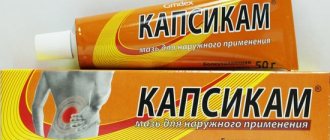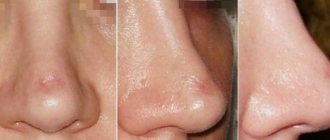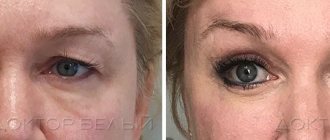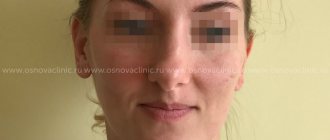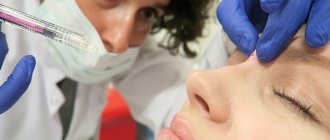An operation to get rid of the “apron” on the stomach is carried out only after a person has completed a weight loss course and got rid of extra pounds. It is often carried out at the request of the patient, since after weight loss, sagging skin causes a lot of trouble psychologically. There are also clear medical indications:
- the functioning of the internal organs of the abdomen is disrupted due to the presence of an “apron”;
- there are problems with blood circulation in the problem area;
- diaper rash regularly forms under the fold;
- There is constant irritation on the skin.
The fat “apron” on the abdomen cannot be removed if the patient still continues to lose weight; the results of the operation will be reduced to zero.
Fat “apron” on the stomach
Contraindications to removing the “apron”:
- malignant neoplasms in any organ or system of the body;
- acute infectious and inflammatory processes, exacerbation of chronic pathologies;
- unstable psyche;
- any neurological pathologies, including epilepsy;
- unstable blood pressure;
- coronary heart disease, strokes, atherosclerosis, thrombophlebitis;
- bronchial asthma.
After surgery to remove the “apron,” a fairly wide, visible scar remains on the abdomen, and you will have to live with it for the rest of your life. Preparation for surgery:
- Compliance with a low-calorie diet for at least 6 months and regular exercise. This will lead to active, but not aggressive weight loss, and will strengthen the muscle frame. The result will be an easier rehabilitation period.
- Refusal 15 days before surgery from drinking alcoholic beverages, smoking and taking certain medications that negatively affect the blood clotting system (Aspirin, Ibuprofen, etc.). Doctors recommend interrupting the course of taking contraceptives.
- Conducting therapy for previously diagnosed chronic pathologies of internal organs and systems.
During the preparatory period, the patient must undergo a comprehensive examination , since surgery is performed under general anesthesia and there are many contraindications to this.
Abdominoplasty
The problem can be solved by two methods - abdominoplasty and panniculectomy. Often these operations are combined with liposuction, in which case we are talking about more complex work for the surgeon and a longer rehabilitation process.
Abdominoplasty to get rid of the “apron” involves the use of general anesthesia and correction of the skin, muscle fibers, and fat layer. Abdominoplasty lasts on average 1-4 hours and has the following advantages:
- the “apron” is eliminated regardless of what stage of obesity is present or how severe the problem is;
- the stomach literally becomes flat due to muscle tightening;
- the resulting effect lasts for life, but only if pregnancy and childbearing are not expected in the future.
Abdominoplasty surgery to remove the “apron” on the stomach is carried out in several stages:
- The surgeon makes an incision in the lower abdomen and peels away the fat layer from the skin.
- The navel is separated from its usual location.
- The doctor eliminates hernias (if any) and solves the problem of muscle tissue discrepancies.
- Excess skin and fat are excised, and the remaining tissue is pulled towards the pubis.
- The navel is fixed in a new place, the incision is sutured, and a sterile bandage is applied.
Abdominoplasty of the abdomen
is often limited to the correction of only the lower part of the abdomen (the directly hanging fold is removed); they can remove only the anterior abdominal wall and not affect the navel.
Panniculectomy is the name of a procedure during which skin and fat are excised, but without muscle correction. The main advantage is obtaining an excellent effect with minor intervention in the problem area. This ensures a faster and easier recovery period.
Due to the minimal amount of work, surgeons allow such an operation to be performed even if there is a history of pathologies of internal organs, as well as with oncology and diabetes.
Panniculectomy
Progress of the operation:
- Introducing anesthesia and making an incision above the pubis and from the sternum to the pubis.
- Excision of excess skin and fat.
- Suturing the surgical wound and installing drainage (it is subsequently removed).
Panniculectomy has a significant drawback: it is characterized by the formation of a large, noticeable scar not only in the lower abdomen, but also along its midline.
Regardless of the method, rehabilitation after surgery lasts on average 1 month . In some cases, it can last 1.5 or 2 months.
What surgeons recommend for quick and effective rehabilitation:
- Until the stitches are removed, do 2-3 dressings a day.
- You should wear a special compression bandage for 1-2 months.
- During the first 1.5-2 months, you need to completely avoid any physical activity.
- You should follow a diet for a month that will ensure normal bowel function and no constipation. Patients are allowed to eat liquid and semi-liquid foods. It is worth giving up white cabbage, fatty meats, and legumes; they provoke increased gas formation and increase the risk of constipation.
Compression bandage after tummy tuck
Possible complications after removing the fat “apron” on the abdomen during abdominoplasty:
- bleeding and hematoma formation;
- suture infection;
- tissue necrosis in the area of suturing the surgical wound;
- problems with abdominal sensitivity (it decreases or disappears altogether);
- formation of too rough scars.
Panniculectomy has a smaller list of complications:
- formation of subcutaneous hematomas;
- suppuration of the suture (infection);
- loss of skin sensitivity;
- scarring of the seam.
If the patient does not comply with the rules of the recovery period, the sutures may come apart, which leads to the need for repeated surgery.
Before and after tummy tuck
Prices for removing an “apron” on the stomach start from 100 thousand rubles, and can reach 500 thousand rubles.
Read more in our article about removing the “apron” on the stomach.
Abdominoplasty: price in Moscow, contraindications, rehabilitation
Eating healthy can build muscle, improve body contour and lose weight, but there are no miracles.
To correct some figure flaws, it may be impossible to do without the help of a plastic surgeon. Such problems are familiar to those with a sagging belly that has lost its elasticity. Only abdominoplasty will help to add aesthetic appeal and make it fit again - abdominoplasty, which helps to cope with excess skin and fat deposits in the abdominal area, as well as stretched abdominal muscles. For women and men who want to have an athletic belly, plastic surgery can sometimes be a real salvation. Today in Moscow there are a huge number of clinics where abdominoplasty is performed. One of them is the Sharm Gold plastic surgery clinic, a modern medical institution that provides quality services in the field of plastic and aesthetic surgery.
Results and rehabilitation period
The operation allows you to completely remove the apron and give the figure a beautiful outline. The patient becomes slim and fit. The achieved result must be maintained by constantly monitoring your weight, eating right, and regularly performing moderate exercise. The scars from the incisions will turn white within a year and stop protruding above the skin, but will not disappear completely. They can be polished with a laser. On the 3-4th day after surgery, the drainage tube is removed.
In the first days, the patient is in the hospital because he requires effective pain relief and frequent dressing changes.
After returning home you need for 1-2 months:
- ensure peace of mind;
- minimize any physical activity;
- do not lift heavy objects (over 4 kg);
- wear a bandage or compression garment for 2 months (or another period recommended by your doctor) to stabilize the result.
In addition, during the recovery period the following is prohibited:
- overheat the intervention area - go to the bathhouse, sauna, take a hot bath;
- visit a public swimming pool;
- sunbathing - both under the sun and in a solarium;
- overeat.
The doctor may additionally prescribe physical therapy to speed up recovery and improve the quality of the skin in the intervention area.
To prevent complications, the doctor prescribes a course of antibiotics. In addition, each patient is recommended a course of treatment for dysbiosis, which can be caused by antibiotics.
When a noticeable fold forms on the stomach, which is called an “apron,” a person experiences complexes and discomfort. A panniculectomy can help, during which not only excess skin is removed, but also fat deposits.
Gvaramiya Eka Yurievna
Participant of congresses, conferences and seminars on plastic surgery. Priority areas: abdominoplasty, blepharoplasty, liposuction, reconstructive plastic surgery.
Abdominoplasty result
Abdominoplasty is not a surgical procedure for the treatment of obesity and weight loss. Abdominal plastic surgery does not help with visceral fat. Patients who are severely overweight need to lose weight before undergoing tummy tuck surgery. Weight loss after abdominoplasty can lead to the formation of new, sagging excess skin.
As a rule, the result of abdominoplasty remains for life. The operation eliminates the hanging belly (the skin-fat “apron” in the lower abdomen) and normalizes the proportions of the figure.
The formation of postoperative scars occurs over a period of 8 months to a year. The surgeon makes some incisions along natural folds, making them less noticeable. If necessary, laser resurfacing of scars is possible.
Progress of the operation
Panniculectomy is performed under general anesthesia. Its duration can reach 8 hours, depending on the complexity and scale of the manipulations.
Typically, two incisions are made:
- horizontal (in the pubic area, from which excess skin and adipose tissue is removed);
- vertical (from the lower border of the sternum to the pubic bone).
After removing the skin-fat apron, the boundaries of the incisions are sutured layer by layer, and a drainage tube is installed.
Diastasis (divergence) of the rectus abdominis muscles can be eliminated at the same time.
Abdominoplasty: types
When selecting the most suitable method of surgical intervention for each specific case, the surgeon takes into account the following nuances: the general health of the patient, the thickness of the fat layer, the tone of the muscles of the anterior abdominal wall and the degree of elasticity of the skin.
Abdominoplasty is recommended for sagging tissue in the abdominal area. For patients who have pronounced age-related changes or significant tissue sagging after a sharp decrease in body weight, it is advisable to undergo a comprehensive body lift - body lifting.
The main types of abdominoplasty used for surgical correction of the abdomen in modern plastic surgery include:
- classical abdominoplasty with relocation of the navel - indications for the use of this technique are: pronounced prolapse of tissues, divergence of the rectus abdominal muscles, hernias. A surgical incision is made in the lower abdomen and around the navel, peeling off all the tissue of the abdominal wall. Excess skin and subcutaneous fat deposits are removed, the tissues of the upper abdomen are stretched, the navel is moved to a new location and sutures are applied. The average duration of the operation is three hours;
- mini abdominoplasty – if aesthetic defects are localized only under the navel, in the lower abdomen. In this case, the surgeon makes an incision in the suprapubic fold, after which he removes excess skin and fat deposits and tightens the muscles. The operation is performed without moving or plasticizing the navel. The stitches after miniabdominoplasty are small and unnoticeable. Mini abdominoplasty usually lasts no more than two hours;
- endoscopic abdominoplasty - this type of surgical correction is indicated if the patient has maintained a normal degree of skin elasticity and has mild muscle ptosis. Endoscopic abdominoplasty involves the insertion of a video camera and special surgical instruments through small punctures in the abdominal wall. During the operation, the surgeon tightens and sutures the muscles without touching the skin. As a rule, endoscopic abdominoplasty complements mini abdominoplasty. The duration of the procedure is from one and a half to two hours;
- plastic correction of the navel - intervention is necessary in the presence of a stretched or protruding navel, if the tone of the muscles of the abdominal wall is preserved and there is no excess skin and subcutaneous fat. The appearance of such an aesthetic defect is most often associated with pregnancy and childbirth or surgical interventions in the abdominal cavity. Thanks to umbilicoplasty, it is possible to restore the shape of the umbilical ring. The operation lasts about an hour.
The cost of abdominal abdominoplasty depends on the degree of neglect of the patient’s problem and the type of surgical correction.
What is a greater omentum
The internal organs of the abdominal cavity are covered with a thin protective layer of connective tissue - the peritoneum.
In the process of evolution, for additional protection of the abdominal cavity, a separate organ was formed - the greater omentum. It is an overgrown peritoneum, consisting of four leaves. The fatty tissue between these leaves gives the organ its name.
The main function of the large oil seal is protection from external shock influences. It starts from the anterior wall of the stomach, covers the loops of the small intestine and ends at the level of the transverse colon.
The greater omentum, like the peritoneum as a whole, is richly saturated with blood vessels and lymphatic channels. Because of this, it is most susceptible to metastasis in malignant tumors of the abdominal cavity and pelvis.
Abdominoplasty: indications
Abdominal tummy tuck can be prescribed to adult patients at any age if they have the following problems:
- excess fat deposits, sagging abdomen;
- sagging of the skin of the abdomen associated with pregnancy, especially multiple pregnancies, or sudden weight loss;
- the formation of a skin-fat “apron” - drooping of the abdomen when the anterior abdominal wall is lowered;
- age-related changes, due to which the tone and elasticity of the skin deteriorate. Performing liposuction on older obese patients risks the formation of stretch marks and stretch marks on their bodies. In these cases, abdominoplasty is preferable.
The main reasons that led to the need for abdominoplasty include:
- sudden weight loss (7-10 kilograms in a short period of time), as a result of which the skin on the stomach sagged;
- pregnancy - the skin of the abdomen is sagging due to excessive tension;
- hormonal imbalance;
- involutional changes with loss of elasticity and skin tone;
- consequences of surgical interventions with incisions on the abdominal wall;
- individual factors - a certain body composition that is inherited.
Laparoscopic access
In most cases, omentectomy operations are currently performed using a gentle laparoscopic method.
To perform such operations, a wide incision in the abdominal wall is not required. Access is created through several small punctures of the skin. Through them, a laparoscope - a miniature video camera with illumination - is inserted inside, as well as surgical instruments.
The image from the video camera is transmitted to the monitor. By observing it, the surgeon controls his manipulations.
This method requires particularly high qualifications and experience, so it is not used in all clinics. The professional level of surgeons at the international clinic Medica24 makes it possible to perform such low-traumatic interventions with minimal risk of complications.
The duration of hospitalization for laparoscopic omentectomy usually does not exceed 3 days, and the rehabilitation period takes no more than 1 month.
Abdominoplasty: contraindications
Abdominoplasty surgery has contraindications. Tummy tuck surgery should not be performed on patients suffering from severe and decompensated chronic diseases:
- respiratory system;
- of cardio-vascular system;
- urinary system;
- digestive tract;
- endocrine system (including diabetes mellitus).
In addition, abdominal plastic surgery is contraindicated for systemic connective tissue pathologies, hemocoagulation disorders, pregnant and breastfeeding women, as well as patients planning pregnancy in the near future. Obese patients should stabilize their weight before surgery.
After operation
The operation is usually performed under general anesthesia. In some cases, epidural anesthesia may be used.
A few hours after the operation, you are allowed to get up, walk, and eat.
In the hospital, the patient is under constant medical supervision, which virtually eliminates postoperative complications.
For a month after discharge from the hospital, you should avoid physical activity, sexual intercourse, as well as visits to the sauna and bathhouse.
We will call you back, leave your phone number
Message sent!
expect a call, we will contact you shortly
Abdominoplasty: preparation for surgery
Before surgical correction of the abdomen, the plastic surgeon conducts a mandatory consultation and examines the patient to assess the elasticity of the tissues, the volume of excess skin and subcutaneous fat, and the condition of the muscles of the abdominal wall. Based on the examination results, the doctor selects the most optimal technique for abdominal plastic surgery or other invasive interventions, which include abdominal liposuction.
To perform abdominoplasty, the patient is given general, endotracheal or combined anesthesia, which requires a comprehensive examination to identify contraindications to its use. For this purpose, modern methods of laboratory and instrumental diagnostics are used:
- general and biochemical blood and urine tests;
- electrocardiography, which allows you to evaluate the work of the heart muscle;
- coagulogram necessary to check blood clotting;
- fluorography;
- laboratory screening for HIV infection, hepatitis B and C, syphilis.
In addition, consultations with narrow specialists are necessary:
- the anesthesiologist-resuscitator selects a safe anesthesia, taking into account the patient’s age and chronic diseases that he has;
- the therapist and phlebologist assess postoperative risks associated with thrombus formation after surgery, based on interpretation of the results of ultrasound examination of the veins of the lower extremities;
- doctors of other specialties, if indicated.
14 days before abdominoplasty, you should avoid taking medications that can lead to decreased blood clotting.
8 hours before surgery, the patient must refuse to eat, since abdominal surgery is performed on an empty stomach.
Abdominoplasty: complications
The individual reaction of the patient’s body or a violation of the rehabilitation regime can provoke the development of postoperative complications, which can be local or general.
Local complications include:
- the occurrence of suppuration in the area of postoperative sutures is due to violation of the rules of asepsis and antisepsis during the operation;
- the appearance of seroma is caused by a loose fit of the wound edges, as well as by simultaneous abdominoplasty and liposuction. The development of this complication can be prevented by wearing compression garments;
- development of hematomas - most often associated with incorrect stopping of bleeding;
- the occurrence of marginal necrosis - due to strong tension of the sutures and excessive tissue preparation, the blood supply to the edges of the wound deteriorates, as a result of which the soft tissues die;
- the appearance of scarring - rough scars occur if the wound was not sutured correctly. This process may also be a consequence of the individual response of the body.
Common complications include:
- anemia – caused by massive blood loss during surgery;
- the occurrence of abdominal companion syndrome - a condition in which the patient's abdominal pressure increases. This complication is caused by excessive tension in the tissues of the abdominal wall or insufficient compliance with the rules of rehabilitation;
- the development of pulmonary edema is a consequence of high intra-abdominal pressure. The appearance of congestive pneumonia is the result of insufficient mobility of the patient in the period after surgery;
- the occurrence of thromboembolism is associated with heart rhythm disturbances, lack of movement and neglect of recommendations for wearing compression garments. To correct the disorder, anticoagulants are prescribed.
If the surgeon follows all the rules for conducting a surgical intervention, and the patient follows the recommendations for rehabilitation, negative consequences in the form of general severe complications develop in extremely rare cases.
Possible complications after removing the fat “apron” on the abdomen
Abdominoplasty and panniculectomy are well-known and frequently performed operations. Doctors are well aware of the stages of manipulation and can foresee some difficulties after examining and interviewing the patient. If the surgeons carried out their work competently, and the patient turned out to be conscientious and complies with all recommendations for rehabilitation without exception, then complications arise extremely rarely, as an exception.
Possible complications after removing the “apron” on the stomach using abdominoplasty:
- bleeding and hematoma formation;
- suture infection;
- tissue necrosis in the area of suturing the surgical wound;
- problems with abdominal sensitivity (it decreases or disappears altogether).
Consequences of abdominoplasty
Complications include the formation of too rough scars - this is an unsatisfactory result from an aesthetic point of view. To prevent this from happening, the surgeon must have the skill and experience of performing cosmetic sutures.
Panniculectomy has a smaller list of complications:
- formation of subcutaneous hematomas;
- suppuration of the suture (infection);
- loss of skin sensitivity;
- scarring of the seam.
If the patient does not comply with the rules of the recovery period, the sutures may come apart, which leads to the need for repeated surgery.
Result of abdominoplasty
Abdominoplasty: rehabilitation
The first few days after abdominal surgery are considered the most difficult. Patients are concerned about pain and discomfort in the abdominal area. To relieve these unpleasant sensations, the plastic surgeon prescribes painkillers.
In the early recovery period, patients experience problems with the functioning of the gastrointestinal tract. To restore intestinal activity, it is necessary to take laxatives and increase fluid intake - you can drink large quantities of both water and fruit juices, fruit drinks.
The patient must remain in bed for at least 5-7 days after abdominoplasty. While in bed in a horizontal position, it is advisable to bend your legs halfway - this will prevent stretching of the skin and minimize the load on postoperative sutures. However, you cannot remain completely immobilized - this condition increases the risk of developing blood clots. At first, small, careful movements of the limbs and light sittings are enough.
In the first two weeks after surgical correction, it is necessary to wear compression garments. This measure helps to relieve swelling, reduce postoperative hematomas and prevent the separation of postoperative scars. Compression garments provide stability to the abdomen and prevent it from moving, which significantly reduces the pain that accompanies any surgical intervention.
Wearing special compression garments speeds up the healing process of postoperative wounds, which is explained by the light massage effect they have on the abdomen, respectively stimulating blood circulation and lymphatic drainage.
When choosing underwear you need to be careful and take into account the following nuances:
- what material was used to make compression garments;
- how high is the compression ratio;
- Does the linen have antibacterial properties and the ability to pass air?
Recommendations for mandatory wearing of compression garments also apply to patients who have undergone mini-abdominoplasty. It can be removed only for a short time, for hygiene procedures.
Sutures are removed 10-14 days after surgery. In order for postoperative sutures to become thin and invisible, it is necessary to apply special silicone dressings to them or use ointments that contain silicone.
There are standard restrictions that should be followed after abdominoplasty. The following activities are prohibited during the rehabilitation period:
- visiting baths, saunas, taking baths with hot water - at least a month after tummy tuck;
- staying on the beach, in direct sunlight, especially if the stomach is not covered;
- playing sports, lifting heavy objects.
In order to speed up your rehabilitation, you need to listen to the following useful tips:
- adjust your menu - give up unhealthy foods: sausages, spicy, salty, fried foods, as well as foods that contribute to gas formation in the intestines;
- organize competent care for postoperative scars using silicone gels and pencils;
- undergo a course of rehabilitation physiotherapeutic procedures, which the attending physician will prescribe after the operation.
The rehabilitation period after abdominoplasty is really difficult. Every patient who seeks help from a plastic surgeon for abdominal correction needs to be prepared for this. However, all the unpleasant moments that you just need to endure will be forgotten immediately when in the reflection of the mirror you see your new, beautiful and toned tummy, without fat and stretch marks.
Frequently asked questions about abdominoplasty
Provided proper nutrition, physical activity and weight control are followed, the results of abdominoplasty last from 10 to 15 years.
Plastic surgery of the abdomen in Moscow is a fairly developed area. Almost any modern clinic offers tummy tuck. Prices in Moscow vary, but on average range from 100,000 to 300,000 rubles. The cost of abdominoplasty depends on the type of operation (classic abdominoplasty, abdominoplasty with diastasis suturing, etc.).
When it comes to health and beauty, you need to focus not on price, but on quality. You cannot save on it by turning to a little-known surgeon in pursuit of cheapness, as the result may be disastrous.
If necessary, repeat abdominoplasty is possible, but only after the patient has fully recovered from the primary abdominoplasty.
The rehabilitation period after tummy tuck is quite long. Its duration depends on the patient’s age, tissue regenerative abilities, type and size of the surgical incision and other nuances.
One of the most famous plastic surgery clinics, according to patient reviews, is the Sharm Gold clinic. The clinic employs plastic surgeons of the highest category who have extensive experience in performing surgical interventions of any degree of complexity.
